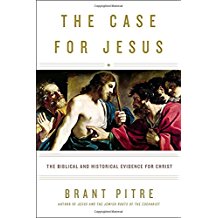Phone: (817) 793-3060

The Case for Jesus by Brant Pitre
Book Review: The Case For Jesus: The Biblical and Historical Evidence for Christ, by Brant Pitre, New York: Image, 2016, 242 pages, hdbk.
I suppose that the first thing I ought to say is that this is not The Case for Christ by Lee Strobel, nor is it related to the set of books spawned by it. This is a new work by a Professor at Notre Dame Seminary in New Orleans.
Coming from the desk of a Roman Catholic readers may want to question what I am doing even bothering to read it. My defense is that some Roman Catholic writers are well worth being acquainted with, and, in fact, ought to be read – though with the caveat that they are Roman Catholics. To name just a few, I think Jay Budziszewski is one of the best writers and speakers to recommend to a college student. Anthony Esolen and Benjamin Wiker are good guides on what to read and what not to read. Robert Barron, who coincidentally wrote the Afterword for the book under review, is worth your time on practically anything, creation and church doctrine apart. And a man who cannot find any benefit from G. K. Chesterton is a reflective sluggard indeed. Alongside of these Brant Pitre deserves a hearing, and especially this book.
The Case For Jesus is, I think, the very best book on its subject for a general audience. It is wonderfully written, very informative, conservative in its conclusions, and is a great faith-builder. Its thirteen compact chapters, which even with Barron’s contribution bring the book in at a mere 242 pages, including endnotes, comprise a consistent push-back against the slippery arguments of Bart Ehrman (Pitre’s main foil) and others like him.
The opening chapter sets the context for the discussions which follow. Of major concern to Pitre is the Telephone Game illustration of Gospel transmission used so effectively by the run of unbelieving scholarship. Anyone who has heard Erhman will be familiar with his mantra that the Gospels are anonymous, the titles we have being added much later. Actually, I have come across this belief even in evangelical authors. But Pitre dispatches this fiction very effectively – by a straightforward appeal to the facts. He points out in chapter two,
The first and perhaps the biggest problem for the theory of the anonymous Gospels is this: no anonymous copies of Matthew, Mark, Luke, or John have ever been found. They do not exist. As far as we know, they never have. (15. Author’s emphasis).
The edifice which Erhman leans upon so heavily is made of air. All of the available manuscript and Patristic evidence points in the other direction. Erhman, a textual critic, is surely close to committing the unpardonable sin of his discipline – of ignoring all the textual evidence in favor of his preferences.
Pitre also asks how such well known and cherished writings managed to be copied and handled without their authors being identified. And how come there is complete unanimity in the ascription of the authors? (19). Related to this is the question of the both internal (within the Gospels themselves) and external (writers outside the Gospels) evidence for whether we know who wrote the Gospels. These issues are covered in chapters three and four. Again, the evidence is “completely unambiguous and totally unanimous.” (39).
The fifth chapter ably handles the inaccurately called “Lost Gospels” while chapter six inquires whether the Gospels fit within the genre of ancient biographies. This impressive chapter closes with a short discussion about whether the Gospels should be viewed as verbatim transcripts. The author decides in favor of the position that word-for-word accuracy is not always present but,
On the other hand, the historical character of the Gospels does mean that the authors intend to record the substance of what Jesus really said and did. (81. Author’s emphasis).
Chapter seven examines the dating of the Gospels. Pitre deals with reasons for fixing the Gospels with a late date and finds them to be seriously flawed (89). This excellent chapter finishes off what I might call the first part of the book. From then on the next six chapters focus on who Jesus is. They continue the high standards set by “part one”. Along the way Pitre works with several prophetic chapters from the Book of Daniel (Dan. 2, 7, and 9). On the whole he addresses himself to these chapters with real competence, and always conservatively. The ninth and tenth chapters are concerned with Jesus’ divinity, while chapters eleven and twelve deal with the crucifixion and resurrection respectively. The resurrection in particular is skillfully handled, with a fine exposition of “the Sign of Jonah”(185-190).
Fittingly, the final chapter is a brief meditation on the identity of Jesus Christ utilizing His question at Caesarea Philippi, “who do you say that I am?” We are left in no doubt about the answer:
In light of everything we’ve seen in this book, one thing is clear: if you are going to hold a theory that Jesus never claimed to be God, you had better be committed to eliminating a lot of historical evidence. (193. Author’s emphasis).
Indeed. Dr Pitre makes his case. And he is helped by a whole company of scholars, from Craig Keener, Richard Bauckham and Martin Hengel to John Meier and Joseph Fitzmyer, whose appearances are most felt in the endnotes.
So buy and read The Case For Jesus, digest its arguments, teach them to others. Do not commit the logical error of shooting the messenger because he is not a Protestant. The author has written a clever rebuttal to the croaking arguments of the skeptics, and I for one am very glad that he did.

Sorry, comments are closed for this post.